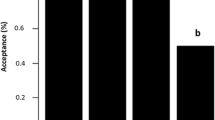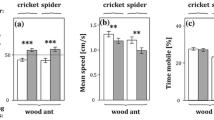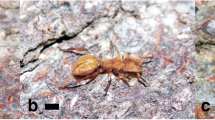Abstract
We studied the predatory behavior of seven species of the genusLeptogenys from Mexico and Cameroon. The ants of this genus are armed with long, thin, curved mandibles articulated at the extreme corners of the anterior margin of the head, permitting them easily to seize oniscoid isopods, the obligate or the principal prey of mostLeptogenys species. Workers hunt these prey, which are able to roll themselves up, solitarily. Foraging behavior comprises sequences of up to eight activities. The prey can be seized by the body (rolled up or not), or alternatively by the edge of the shell, then turned over and stung on the ventral face. A relationship between the mandible size of the workers and the handling method permitted us to established that the phase “seizure by the edge of the shell” (compared to grasping the prey by the body) was more frequent as the prey size increased or the mandible length of the workers decreased. The rate of prey escape followed the same pattern. When a prey escaped, workers reacted by using a local searching or “reserve” behavior: they moved by increasing both sinuosity and speed. Recruitment occurred mainly after a worker found a group of prey or a large prey.L. mexicana are attractive at a distance to the isopods Bathytropidae living in the same natural environment. As a consequence, prey capture is possible without foraging for this species.
Similar content being viewed by others
References
Amold, G. (1915). A monograph of the Formicidae of South Africa.Ann. South Afr. Mus. 14: 1–766.
Bolton, B. (1973). The ant genera of West Africa: A synonimic synopsis with keys (Hymenoptera: Formicidae).Bull. Br. Mus. (Nat. Hist.) 27: 317–368.
Bolton, B. (1975). A revision of the ant genusLeptogenys Roger (Hymenoptera: Formicidae) in the Ethiopian region. With a review of the Malagasy species.Bull. Br. Mus. (Nat. Hist.) 31: 237–305.
China, W. E. (1928). A remarkable bug which lures ants to their destruction.Nat. Hist. Mag. 1: 209–213.
Dejean, A. (1985a). Etude éco-éthologique de la prédation chez les fourmis du genreSmithistruma (Formicidae, Myrmicinae, tribu des Dacetini). II. Attraction des proies principales.Insectes Soc. 32: 158–172.
Dejean, A. (1985b). Etude éco-éthologique de la prédation chez les fourmis du genreSmithistruma (Formicidae, Myrmicinae, tribu des Dacetini). III. La capture des proies chezS. emarginata.Insectes Soc. 32: 244–256.
Dejean, A. (1988a). Failure as an efficient stimulus of a “reserve behaviour” which allows the capture of alternative prey bySerrastruma serrula workers (Formicidae, Myrmicinae).Sociobiology 14: 325–339.
Dejean, A. (1988b). Determination of the hunting strategy in the genusSmithistruma (Formicidae, Myrmicinae) by the kind of prey.Behav. Proc. 16: 111–125.
Dejean, A. (1997). Distribution of colonies and prey specialization in the ponerine ant genusLeptogenys. Sociobiology 29 (in press).
Duncan, F. D. (1992). Foraging strategies ofLeptogenys nitida (Hymenoptera: Formicidae). In Billen, J. (ed.),Biology and Evolution of Social Insects, Leuven University Press, Leuven, pp. 319–323.
Duncan, F. D., and Crewe, R. M. (1994). Group hunting in a ponerine ant,Leptogenys nitida Smith.Oecologia 97: 118–123.
Fletcher, D. J. C. (1971). The glandular source and social functions of trail pheromones in two species of ants (Leptogenys).J. Entomol. 46: 27–37.
Fletcher, D. J. C. (1973). “Army ant” behaviour in the Ponerinae: A re-assessment.Proc. VIIth Conf. IUSSI, London, pp. 116–121.
Freitas, A. V. L. (1995). Nest relocation and prey specialization in the antLeptogenys propelfalciferas Roger (Formicidae: Ponerinae) in an urban area in southern Brazil.Insectes Soc. 42: 453–456.
Garnett, W. B., Akre, R. D., and Sehlke, G. (1985). Cocoon mimicry and predation by myrmecophilous diptera (Diptera: Syrphidae).Fla. Entomol. 68: 615–621.
Gorvett, H. (1956). Tegumental glands and terrestrial life in woodlice.Proc. Zool. Soc. London 126: 291–314.
Hölldobler, B., and Wilson, E. O. (1990).The Ants, Belknap Press of Harvard University Press, Cambridge, MA.
Howard, R. W., Akre, R. D., and Garnett, W. B. (1990a). Chemical mimicry in an obligate predator of carpenter ants (Hymenoptera: Formicidae).Ann. Entomol. Soc. Am. 83: 607–616.
Howard, R. W., Standley-Samuelson, D. W., and Akre, R. D. (1990b). Biosynthesis and chemical mimicry of cuticular hydrocarbons from the obligate predator,Microdon albicomatus Novak (Diptera: Syrphidae) and its ant prey,Myrmica incompleta Provancher (Hymenoptera: Formicidae).J. Kans. Entomol. Soc. 63: 437–443.
Huber, I. (1979). Prey attraction and immobilization by allomone from nymphs ofWomeria strandtmanni (Acarina: Trombiculidae).Acarologia 20: 112–115.
Jacobson, E. (1911). Biological notes on the HemipteronPtilocerus ochraceus.Tids. voor Entomol. 54: 175–179.
Kumar, A. R. V. (1990). Batch strench of hunting groups inLeptogenys diminuta (Formicidae: Ponerinae). In Veeresh, G. K., Mallik, B., and Viraktamath, C. A. (eds.),Social Insects and the Environment, E. J. Brill, Leiden, pp. 562–563.
Lévieux, J. (1977). La nutrition des fourmis tropicales. V. Eléments de synthèse: Les modes d’exploitation de la biocénose.Insectes Soc. 24: 235–260.
Lévieux, J. (1983). The soil fauna of tropical savannas. IV. The ants. In Bourlière, B. (ed.),Tropical Savannas, Elsevier, Amsterdam, pp. 525–540.
Longhurst, C., Baker, R., and Howse, P. E. (1978). Chemical crypsis in predatory ants.Experientia 35: 870–872.
Maschwitz, U., and Mühlemberg, M. (1975). Zür Jaardstrategie einger orientaliischerLeptogenys-Arten (Formicidae: Ponerinae).Oecologia 20: 65–83.
Maschwitz, U., and Schönegge, P. (1977). Recruitment gland ofLeptogenys chinensis. A new type of pheromone gland in ants.Naturwissenschaften 64: 589.
Maschwitz, U., and Schönegge, P. (1983). Forage communication, nest moving recruitment, and prey specialization in the oriental ponerineLeptogenys chinensis.Oecologia 57: 175–182.
Maschwitz, U., Steghaus-Kovac, S., Gaube, R., and Hänel, H. (1989). A south Asian ponerine ant of the genusLeptogenys (Hym., Form.) with army ant life habits.Behav. Ecol. Sociobiol. 24: 305–316.
Mill, A. E. (1982). Faunal studies on termites (Isoptera) and observations on their ant predators (Hymenoptera: Formicidae) in the Amazon basin.Rev. Bras. Entomol. 26: 253–260.
Peeters, C. P. (1997). Morphology of “primitive” ants: Comparative revue of social characters, and the importance of queen dimorphism. In Choe, J., and Crespi, B. (eds.),The Evolution of Social Behavior in Insects and Arachnids, Cambridge University Press, Cambridge, MA, pp. 372–391.
Schmalfuss, H. (1984). Eco-morphological strategies in terrestrial isopods.Symp. Zool. Soc. London 53: 49–63.
Steghaus-Kovac, S., and Maschwitz, U. (1993). Predation on earwigs: A novel diet specialization within the genusLeptogenys (Formicidae: Ponerinae).Insectes Soc. 40: 337–340.
Sutton, S. L. (1980).Woodlice, Pergamon Press, New York.
Trager, J. C., and Johnson, C. (1988). The ant genusLeptogenys (Hymenoptera: Formicidae, Ponerinae) in the United States. In Trager, J. C. (ed.),Advances in Myrmecology, E. J. Brill, New York, pp. 29–33.
Vander Meer, R. K., and Wojcik, D. P. (1982). Chemical mimicry in the myrmecophilous beetleMyrmecaphodius excavaticolis.Science 218: 806–808.
Wheeler, W. M. (1904). A crustacean-eating ant (Leptogenys elongata Buckley).Biol. Bull. Marine Biol. Lab. Woods Hole 6: 251–259.
Wheeler, W. M. (1910).Ants: Their Structure, Development and Behavior, Columbia University Press, New York.
Wheeler, W. M. (1922). Ants of the Belgian Congo. Part 2. Ants collected by the American Museum Congo Expedition.Bull. Am. Mus. Nat. Hist. 45: 39–269.
Wheeler, W. M. (1936). Ecological relations of ponerine and other ants to termites.Proc. Am. Acad. Arts Sci. 71: 159–243.
Wilson, E. O. (1958a). Studies on the ant fauna of Melanesia. I. The tribeLeptogenyini. II. The tribesAmblyoponini andPlatythyreini.Bull. Mus. Comp. Zool. Harvard 118: 101–153.
Wilson, E. O. (1958b). The beginnings of nomadic and group-predatory behavior in the ponerine ants.Evolution 12: 24–31.
Wilson, E. O. (1959). Some ecological characteristics of ants in New Guinea rain forests.Ecology 40: 437–447.
Author information
Authors and Affiliations
Rights and permissions
About this article
Cite this article
Dejean, A., Evraerts, C. Predatory behavior in the genusLeptogenys: A comparative study. J Insect Behav 10, 177–191 (1997). https://doi.org/10.1007/BF02765551
Issue Date:
DOI: https://doi.org/10.1007/BF02765551




